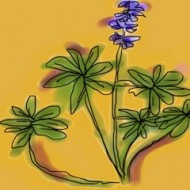The Dry Garden: Not cool
The most common mistake bruited about Los Angeles is that it’s in a desert. It’s not. It’s in one of five of the world’s Mediterranean climate zones, which means that it has a largely temperate but dry climate with winter rain and rainless summers. That said, last Monday, we got a taste of what really living in a desert is like. Santa Ana winds out of the high desert of the Great Basin drove temperatures to 113F in downtown Los Angeles. If your garden wasn’t stressed, you probably don’t have one. Click here for this week’s Dry Garden column in the LA Times on how to irrigate in Southern California during the October-December Santa Ana season.…
The Dry Garden: Wild in Westwood
Katarina Eriksson, former manager of the herb garden at the Huntington and now manager of Rancho Santa Ana Botanic Garden's new Grow Native Nursery in Westwood. She stands on a site that last week was about to be leveled to make way for 10,000 plants. In a partnership with the federal Department of Veterans Affairs, returned servicemen and women will be working with Eriksson in the nursery, which opens this weekend. Click on the image for more information. Photo: Emily Green
For many Southern Californians, switching from a conventional landscape to a native plant garden starts on the freeways.
The best nurseries can be a long drive away. Only in recent years have some native plant outposts crept into relatively central parts of Los Angeles. The Theodore Payne Foundation for Wildflowers & Native Plants runs the most fragrant stall at the Sunday Hollywood Farmers Market, and in January Rancho …
The Dry Garden: “a strong La Niña”
The blue purple band in the center is a building La Niña in the equatorial Pacific. Source: Jason satellite/JPL. Click on the image to be taken to JPL's El Niño/La Niña compendium of Jason images.
Autumn and early winter are traditionally considered planting season in Southern California because nature can be expected to cooperate. As days shorten and rains come, seeds germinate, newly transplanted saplings deepen their roots and established plants awaken from dormancy.
Yet not all years are created equal, and this coming planting season has all the hallmarks of a tricky one.
National Weather Service predictions for a La Niña cycle are becoming less tentative and more ominous. That means ocean temperature trends in the equatorial Pacific have shifted to the opposite of last winter — a way that augurs drought.
How dry our rainy season might be is unknowable; this brooding La Niña might even produce a …
The Dry Garden: Orb weavers
In the oldie but greatie department, The Dry Garden this week reprises a 2005 foray by two leading entomologists through the haunts of the most common garden and household spiders of Southern California. For those who didn’t get snared the first time, and who, like me, love spiders, click here. Or to find Dry Garden events for September, click here. Or for information about the Spider Pavilion at the Natural History Museum of Los Angeles County, which opens September 26, click here.…
The Dry Garden: Dig it
The fig beetles seem late this year, and maybe they are. It’s been unseasonably cool for much of the summer. Yet when these drowsy fliers properly known as Cotinis mutabilis appear, it’s a cue. It’s time to empty the contents from the bottom of your compost bins to make room for fresh additions at the top.
Why? These bugs, also called June beetles, are in search of decomposing vegetation in which to lay eggs, where their grubs will become an integral part of the composting process. If you want to enlist these most excellent helpers and prepare your compost bin for fall planting, the time to do it is now.
You will need a pitchfork, a wheel barrow, some burlap, a scoop shovel and fluent profanity.
Click here to keep reading ‘The Dry Garden’ in the Los Angeles Times. Then by all means please return to check newly compiled listings …
« go back — keep looking »

